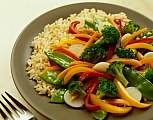
Brown rice (or otherwise called "hulled rice") is unmilled or partly milled rice, a kind of whole grain. It has a mild nutty flavor, is chewier than white rice, becomes rancid more quickly, but is far more nutritious. Any rice, including sticky rice, long-grain rice, or short-grain rice, may be eaten as brown rice.
In some parts of the world, the word "to eat" literally means "to eat rice." All varieties of rice are available throughout the year, supplying as much as half of the daily calories for half of the world's population.
The process that produces brown rice removes only the outermost layer, the hull, of the rice kernel and is the least damaging to its nutritional value. The complete milling and polishing that converts brown rice into white rice destroys 67% of the vitamin B3, 80% of the vitamin B1, 90% of the vitamin B6, half of the manganese, half of the phosphorus, 60% of the iron, and all of the dietary fiber and essential fatty acids. Fully milled and polished white rice is required to be "enriched" with vitamins B1, B3 and iron.
The Difference Between Brown Rice and White Rice
Brown rice is simply white rice that has not had the bran covering the rice grains removed. Removing the bran is done so that the rice is fluffier and cooks faster. Since brown rice still has the bran intact, it is a much better source of fiber. In fact a cup of brown rice has 3.5 grams of fiber while white rice has less than one gram of fiber. We all need from 15 to 25 grams of fiber in our diet every day.Another benefit from eating brown rice is caused by the fiber slowing down the absorption of carbohydrates. This will help tame the blood-sugar roller coaster that can happen from a high sugar-low fiber meal. Fiber also has a healthy effect on our cholesterol levels and may help to reduce this risk of cardiovascular disease.
Besides the fiber found in the brown rice, the bran contains nutrients like magnesium, manganese, selenium, tryptophan and zinc. White rice has reduced levels of these nutrients, but is often fortified with iron, and some B vitamins.
| ||||||||||||||||||||||||||||||||||||||||||||||||||||||






No comments:
Post a Comment